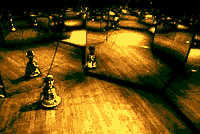T
R
A
N
S
C
R
I
P
T
2
3
4
5
6
7
8
9
10
11
12

|
T R A N S C R I P T |
1
2 3 4 5 6 7 8 9 10 11 12 |
 |
|
|
("where I can see my house from here so we are" video segment)  .
.The work creates an immediate sense of dislocation, a making-ambiguous of the sense of "here" and "there", qualities which I value more in this work than the more lovable aspects of "connecting over the Internet" or "taking on new personalities". It defi nitely a kind of hell in cyberspace, and obviously, this work is no simple chat-room on America Online, no utopian telematic embrace. One sees, at very low resolution and with much time-lag, into a life-size hall of mirrors, where it is nearly impossible to distinguish between the puppet who is "you", its reflection, and the other puppets and their many reflections. So in this state of mind, conversations tend to expressions of "where am I?", "is that me or you?", "which way am I going?", etc. And I ha ve to admit that, to a great extent, I was aiming a critical jab at this notion of purely open-interaction, at online sentimentality, and at the kind of conversation that I was finding online up to those days when I began working on it. It also addresses , in a rather overtly dystopic way, the new possibility at that time of sending realtime video over the Internet, which was still dominated entirely by text. And I was also thinking about radio - ham radio and CB radio, and the experiments I had made wit h these. After all, what would three people who don't know each other and can't see each other's faces have to say to each other? If I gave people a means to communicate, it was overwhelming mediated by the qualities of the work I had devised and the te chnology was both medium and subject, in a way. What I really have imagined for this work from the beginnings in 1993 is that it needs to be a permanent installation somewhere, in order for a very particular sub-subculture to develop around it . I do imagine it as a kind of public space, a kind of public hell.
|